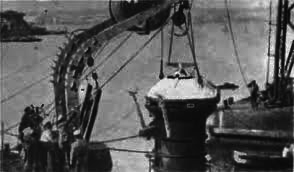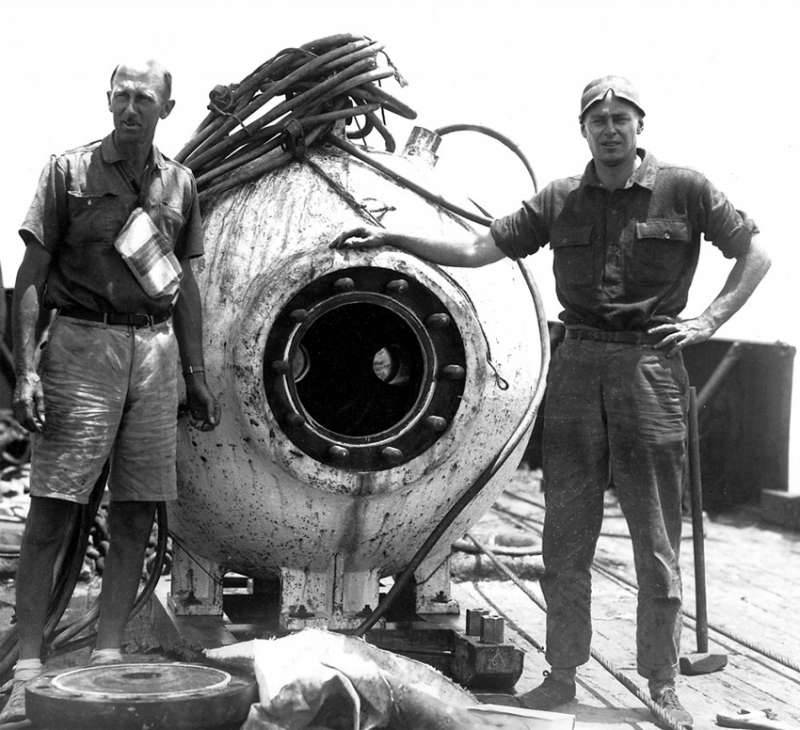"Step to the bottom": the development of deep-sea descent vehicles of the first half of the twentieth century

Apparatus Danilevsky during the search for "Black Prince".
Structurally, these devices allowed to descend to any depth, and the depth of immersion of the device depended only on the strength of the materials from which they were made, because without this condition they could not withstand the enormous pressure increasing with depth.
The first designer of such a device, which reached the depth of immersion 458 m, was an American inventor engineer Gartman.
The apparatus for deep-sea descents built by Hartmann was a steel cylinder, and the internal diameter of this cylinder was such that it allowed one person to fit in it in a sitting position. For observations, the walls of the cylinder were equipped with portholes, which were covered with very strong three-layer glass. Inside the apparatus, above the portholes, electric lamps were arranged, reflecting light with the help of parabolic reflectors. The current for the lamp was obtained from a 12-volt battery placed in the apparatus. The apparatus was equipped with a portable automatic oxygen device, the operation of which provided the divers with oxygen for two hours, chemical devices for absorbing carbon dioxide, a small telescope and a photographic apparatus. There was no telephone communication with the surface base. In general, the whole device of the apparatus was rather primitive.
In late autumn 1911, in the Mediterranean, near Aldeboran Island, east of Gibraltar, Hartmann made his famous descent from the steamer Hansa to a depth of 458 meters, the duration of the descent was just 70 minutes. “When a great depth was reached,” wrote Hartmann, “consciousness somehow immediately suggested the danger and primitiveness of the apparatus, as indicated by the intermittent crackling inside the chamber, like pistol shots. The consciousness that there are no means to report upstairs and the inability to give an alarm signal terrified. At this time, the pressure was 735 psi. an inch of the apparatus, or the total pressure was calculated in 4 million pounds. No less terrible was the thought of the possibility of breaking the lifting cable or its entanglement. In the intervals between the stops, which acted soothingly, there was no certainty whether the device was sinking or being lowered. The walls of the chamber were again covered with moisture, as was the case in preliminary experiments. It was not possible to say whether it was only fogging or water was driven by terrible pressure through the pores of the apparatus. Soon fears gave way to surprise at the sight of fantastic representatives of the animal kingdom. Panorama of the most bizarre life, which was first observed by the human eye, came during the descent. In the water illuminated by the sun for the first thirty feet, moving fish and other creatures were observed. ”
This is the first deep-water descent ended safely. Subsequently, the US government used the Hartmann apparatus during the First World War to photograph sunken German boats and to designate them on maps.
In 1923, a chamber apparatus similar to the Hartmann apparatus was built by the Soviet engineer Danilenko. The Danilenko apparatus was used by the expedition of the underwater operations of the Black and Azov Seas to inspect the bottom of Balaklava Bay, undertaken in connection with the search for the “Black Prince” - an English steam military vessel that sank in 1854. The device Danilenko had a cylindrical shape. At the top of it were located one above the other two rows of portholes intended for the inspection of sunken objects. In order to expand the field of view outside it, a special mirror was installed, with the help of which the image of the ground was reflected in the windows. This device consisted of three "floors". The room for two observers was arranged in the upper part of the apparatus, where hoses were conducted to supply fresh air and to remove spoiled air. In the second "floor" - under the premises for observers - there were mechanisms, electrical devices designed to control the ballast tank in the first "floor". The vehicle was lowered and raised using a steel cable and lasted (to a depth of 55 m) no more than 15-20 minutes.
Not to mention also the interesting crab-shaped deep-sea Reed apparatus. This device was designed to stay at a great depth of two people for 4 hours. It was installed on a controlled inside tractor and could move along the bottom. Reed's apparatus was designed so that people sitting in it could control two levers, with the help of which it was possible to perform various works on drilling large (up to 20 cm in diameter) holes in a sunken ship, laying hoses in these openings, etc.
In 1925, the Americans undertook a deep-sea study of the Mediterranean. The purpose of this expedition is to study the cities of Carthage and Pozilito sunk in the sea, a survey of the Greek treasure gallery that sank on the northern coast of Africa, with which many bronze and marble statues were already raised and were once placed in the museums of Tunis and Bordeaux. In addition to these extracted remarkable works of ancient art, the galley also contained 78 texts embossed on bronze sheets.
The chamber of the Mediterranean expedition apparatus, designed to dive to 1000 m, consisted of a double-walled cylinder made of high-quality steel. The inner diameter of this chamber is 75, see. It was designed for two people who were placed one above the other. The camera was equipped with devices for determining the depth and temperature, telephone, compass and electric heaters, in addition, it was equipped with a perfect photographic device, with which it was possible to make underwater shooting from the same distance as the human eye sees. Under the camera, a heavy load was suspended with an electromagnet, which in the event of an accident could be dropped so that the camera floats to the surface. For rotation and inclination of the camera in the water, it was equipped with two special propellers. Outside, special devices were built that allowed researchers to catch sea animals and keep them in water under such pressure that would ensure the life of these animals.
Batisfer Biba. William Beebe himself on the left.
Finally, the latest construction in this area is the famous spherical batisphere of the American Beebe, a researcher at the Bermuda Biological Station. Biba's cell was connected to the base ship by a cable on which it was immersed in water and cables to supply electricity to the cell and to communicate with the ship. The supply of researchers located in the bathysphere with oxygen and the removal of carbon dioxide from the latter was carried out by special machines. With the help of the bathysphere, Bib accomplished in 1933-1934. a number of descents, and during one of them the researcher managed to reach the depth of 923 m.
However, the outboard devices associated with the ship base had a number of drawbacks: the ascent and descent of such a device to a greater depth required the expenditure of a large amount of time and the presence of bulky lifters on the ship base. The duration of the immersion of the apparatus at great depth is associated with the possibility of a catastrophe. In addition, this camera, being suspended from the ship on a long flexible cable, will all the time, regardless of the will of the observers, move in the water, which greatly worsens the conditions of observation.
In this regard, in the USSR, the idea of building an autonomous self-propelled apparatus for deep-water descents. This project involved the creation of a hydrostat having a cylindrical hull shape with an extended axis. In the upper part of the apparatus there should have been a superstructure, thanks to which the hydrostat would acquire stability and buoyancy in the surface position. Nowhere, however, in the project description it was not said that this “superstructure” or “float” would be filled with kerosene. That is, only internal volume would tell him positive buoyancy!
The height of the hydrostat with the superstructure is 9150 mm, and the height of one service room only 2100 mm. The weight of the whole apparatus was assumed to be about 10555 kg, the outer diameter of the cylindrical part - 1400 mm, the maximum depth of immersion - 2500 m.
The descent of the hydrostat to the depth of 2500 m could last about 20 minutes, and the rise about 15 minutes. The project provided for the possibility to regulate the speed of the dive and the rise, and if necessary, the speed could be increased to 4 m / s, which reduced the rise time to 10 minutes.
The hydrostat was designed to stay under the water of two people for 10 hours, if necessary, the number of the hydrostat crew could be increased to 4 people, and also the duration of its stay under water was increased. When the hydrostat floated on the surface of the water, with a closed clinker, by means of which the cylindrical superstructure communicated with the outboard water, it had a buoyancy margin in 2000 kg. The height of the underwater board at the same time would not exceed 130, see. The hydrostatic immersion system worked by releasing and injecting a certain amount of water into the equalizing tank.
It was supposed to supply it with two weights (150 kg), which are discharged in cases where the ascent of the hydrostat must be accelerated. To increase the speed of immersion to the hydrostat, an additional load could be suspended on a cable of length 100 m. The weight of this load depends on the desired sink rate. In addition, this additional load also serves to prevent the hydrostat from hitting the bottom during a fast dive. At the bottom of the hydrostat, under the bottom platform, is the battery compartment. In the same room there had to be an original turning mechanism, the purpose of which was to inform the hydrostat about the rotation around the vertical axis so that it could turn under water for observation. Now thrusters are doing an excellent job with this. But then the designers came up with a mechanism consisting of a flywheel mounted on a vertical shaft. The upper end of this shaft is connected to an 0,5 kW electric motor.
Flywheel weight should be about 30 kg, and the maximum number of revolutions about 1000 per minute. And he worked like this: when the flywheel rotates in one direction, the hydrostat turns in the opposite direction. It was believed that the mechanism allows the rotation of the hydrostat 45 degrees for one minute.
The hydrostat had to be equipped with three windows, one of which was designed to observe the surrounding water space, the second to observe the sea floor with the help of mirrors, the third to produce flashes for photographing.

Batisfera on the cover of the magazine "Technology-Youth."
To regulate the flow of water into the leveling tank and into the hydraulic mechanism by which cargo is dropped, for supplying compressed air and for other purposes, the project author provides a complex system of pipelines.
This was in the most general terms the project of the Soviet bathysphere, which was written about in technical journals of the time, that this is a good example, “indicating that the time is not far when the people of our wonderful country who conquered the North Pole and the stratosphere will conquer homeland and the deepest bowels of the ocean, where man has never penetrated. ” But ... it turned out that the construction of this device was hindered (and perhaps fortunately, it was very difficult by design) war, and after it appeared devices of a completely different type. But this is completely different. story...

Information